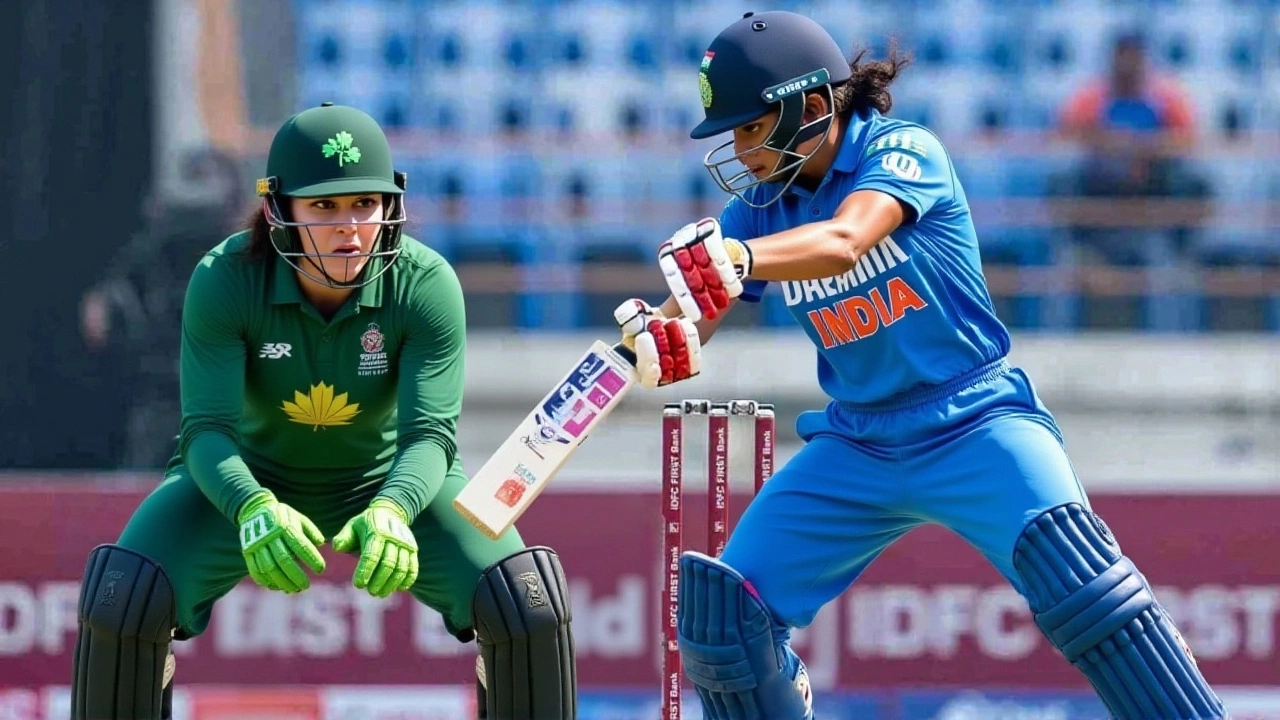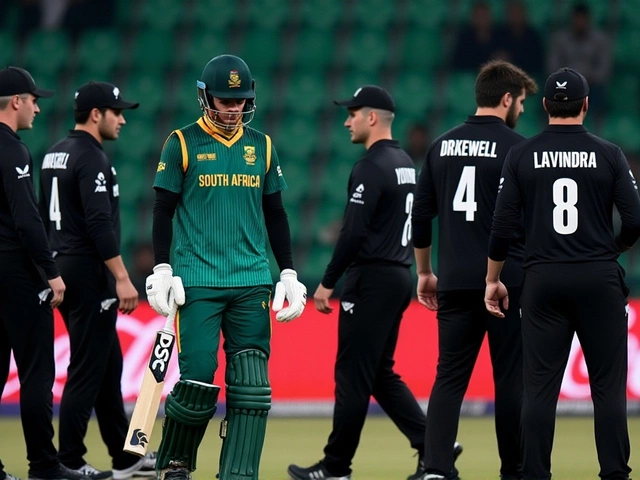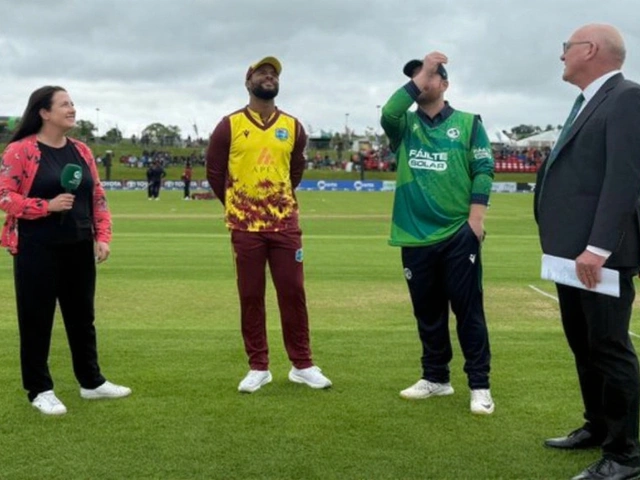When Daryl Mitchell smashed his century off 107 balls on a damp Christchurch morning, few expected the final overs to be this tense. But they were. New Zealand held their nerve to beat West Indies by just 7 runs in the first ODI of their 2025 series — a match that ended at 3:26 PM IST, with the crowd at Hagley Oval on its feet until the very last ball. The victory, sealed at 269/7 after New Zealand batted first, left West Indies stranded at 262/6 — a chase that looked winnable until the final five overs unraveled. It’s not often a 7-run win feels like a heartbreak, but this one did.
A Batting Masterclass, Then a Bowling Miracle
New Zealand’s innings was built on resilience. After losing Rachin Ravindra and Will Young for 24 runs inside six overs — a shock collapse that had fans holding their breath — Daryl Mitchell stepped in like a man possessed. His 100 came with four fours and a single six, a calm counterpunch to early chaos. He shared crucial partnerships with Devon Conway and Tom Latham, and when the lower order accelerated, it was Mitchell who held the middle together. The Powerplay 3 (overs 40–50) yielded 84 runs, a brutal final surge that took New Zealand from 185 to 269. The last three wickets fell in just 8.1 overs, but by then, the damage was done.Enter Kyle Jamieson. The tall paceman, who’s been quietly rebuilding his reputation after injury setbacks, delivered the spell of the match: 3 for 52 in 10 overs. His yorker to dismiss Shai Hope in the 35th over — a ball that kissed the top of off-stump — was a masterclass in pressure bowling. When Matt Henry and Zak Foulkes held their lines, West Indies’ chase began to unravel. Foulkes, in particular, was a revelation: 6 overs, 22 runs, 1 wicket. His economy rate of 3.67 was the quiet engine of New Zealand’s defense.
West Indies’ Chase: Promise, Then Panic
West Indies started well. John Campbell and Alick Athanaze put on 70 for the first wicket — a rare sign of stability against New Zealand’s new-ball attack. But the middle order, historically their Achilles’ heel, failed again. Keacy Carty’s dismissal at 87/3 shifted momentum. Then came Shai Hope, the team’s anchor, out for 51 off 72 balls — caught behind off Jamieson. By the time Roston Chase fell at 169/5, the required rate had climbed to 8.5 an over. Sherfane Rutherford’s late cameo (41 off 28) gave a flicker of hope, but with 53 needed off the final 6 overs, even his power-hitting couldn’t bridge the gap.What made the loss sting more? West Indies had 7 wickets in hand at 126/3 after 33 overs. They were in the driver’s seat. But New Zealand’s field placements — especially the tight inner circle — and the accuracy of their spinners (Santner and Bracewell) turned the screws. The West Indies batsmen, used to flat pitches in the Caribbean, looked uncomfortable on a pitch that offered subtle seam movement and variable bounce. They didn’t panic. They just couldn’t find the boundaries when they needed them most.
Umpires, Context, and the Bigger Picture
The match was officiated by a strong trio: Allahuddien Paleker (South Africa), Chris Brown (New Zealand), and Kumar Dharmasena (Sri Lanka). No controversial decisions. No drama. Just clean, professional umpiring — a quiet backdrop to the drama on the field.This ODI is part of a broader West Indies in New Zealand, 3 ODI Series, 2025, which follows a tightly contested T20I series. New Zealand won three of the five T20Is, including a dramatic 3-run win in the second match at Eden Park. The momentum clearly favors the home side. But West Indies aren’t out of it. Their top order showed signs of growth. And if they can fix their middle-order fragility, this series is far from over.

What’s Next? Pressure Builds
The second ODI is scheduled for November 19 at the same venue. New Zealand will want to close the door on the series early — especially after their T20I dominance. But West Indies, under pressure, might just play with freedom. Expect a tactical battle: will New Zealand rotate their pace attack, or stick with Jamieson and Henry? Will West Indies promote Roston Chase or give a debut to young all-rounder Jayden Seales?One thing’s certain: the next match won’t be a formality. New Zealand’s 1-0 lead feels thin. West Indies have the talent. They just need to believe.
Behind the Numbers
- New Zealand’s total: 269/7 in 50 overs (run rate: 5.38)- West Indies’ chase: 262/6 in 50 overs (run rate: 5.24)
- Daryl Mitchell: 100 (107 balls, 12 fours, 1 six)
- Kyle Jamieson: 3/52 in 10 overs
- Matt Henry: 1/20 in 6 overs
- Zak Foulkes: 1/22 in 6 overs
- Powerplay 1 (West Indies): 32/1 in 10 overs
- Powerplay 3 (New Zealand): 84/3 in 10 overs
- Wides: 7 | No-balls: 0 | Extras: 12 (7w, 5lb)
- Match duration: 5 hours 26 minutes
Frequently Asked Questions
How did Daryl Mitchell’s century impact the match outcome?
Mitchell’s 100 not only steadied New Zealand after a 24/2 collapse, but also gave them a competitive total of 269. His strike rate of 93.46 in the final 20 overs shifted the balance, allowing lower-order hitters like Santner and Bracewell to accelerate without pressure. Without his innings, New Zealand likely would have posted under 240 — a total West Indies could have chased comfortably.
Why did West Indies fail despite having 7 wickets in hand at 126/3?
New Zealand’s disciplined spin and pace attack, particularly in the middle overs, choked the scoring. The field placements were tight, and the bowlers consistently hit the corridor of uncertainty. West Indies’ batsmen lacked rotation skills on a pitch that didn’t offer much turn or pace, and they lost momentum after Hope’s dismissal. They needed 144 off 17 overs — a rate of 8.5 per over — which proved too steep under pressure.
What role did Kyle Jamieson play beyond his 3 wickets?
Jamieson’s presence forced West Indies to play cautiously, especially against the short ball. His 10-over spell contained just 10 boundaries and kept the run rate under 5.2. He didn’t just take wickets — he broke partnerships and shifted momentum. His ability to bowl 140+ kph on a slow pitch created discomfort for right-handers, and his yorker to dismiss Hope was the turning point of the chase.
How does this result affect New Zealand’s World Cup preparation?
This win is a major confidence booster. New Zealand’s middle order, long a concern, showed depth. Mitchell’s form, Jamieson’s return to peak fitness, and Foulkes’ emergence as a death-over option suggest they’ve solved key puzzle pieces. With the 2027 World Cup looming, this performance signals they’re building a balanced, adaptable unit — especially in chase scenarios.
Is this West Indies’ biggest missed opportunity in recent ODI history?
It’s up there. Chasing 270 in New Zealand is tough, but with 7 wickets and 17 overs left at 126/3, they had a 60%+ win probability. The last time they came so close to beating New Zealand in an ODI was in 2019 in Wellington — also lost by 8 runs. This loss echoes that one: same pattern, same collapse, same frustration. The gap between talent and execution remains their biggest hurdle.
What’s the significance of Zak Foulkes’ performance?
Foulkes, a 23-year-old right-arm medium pacer, was a surprise pick. His 6-over spell of 1/22 with a 3.67 economy rate suggests he’s ready for the spotlight. He bowled with control, didn’t overcommit, and kept the ball tight during West Indies’ power-hitting phase. If he keeps this up, he could replace the aging Jacob Duffy in the death overs — a long-term solution New Zealand didn’t know they needed.
- Poplular Tags
- cricket
- Daryl Mitchell
- New Zealand
- Hagley Oval
- ODI series











